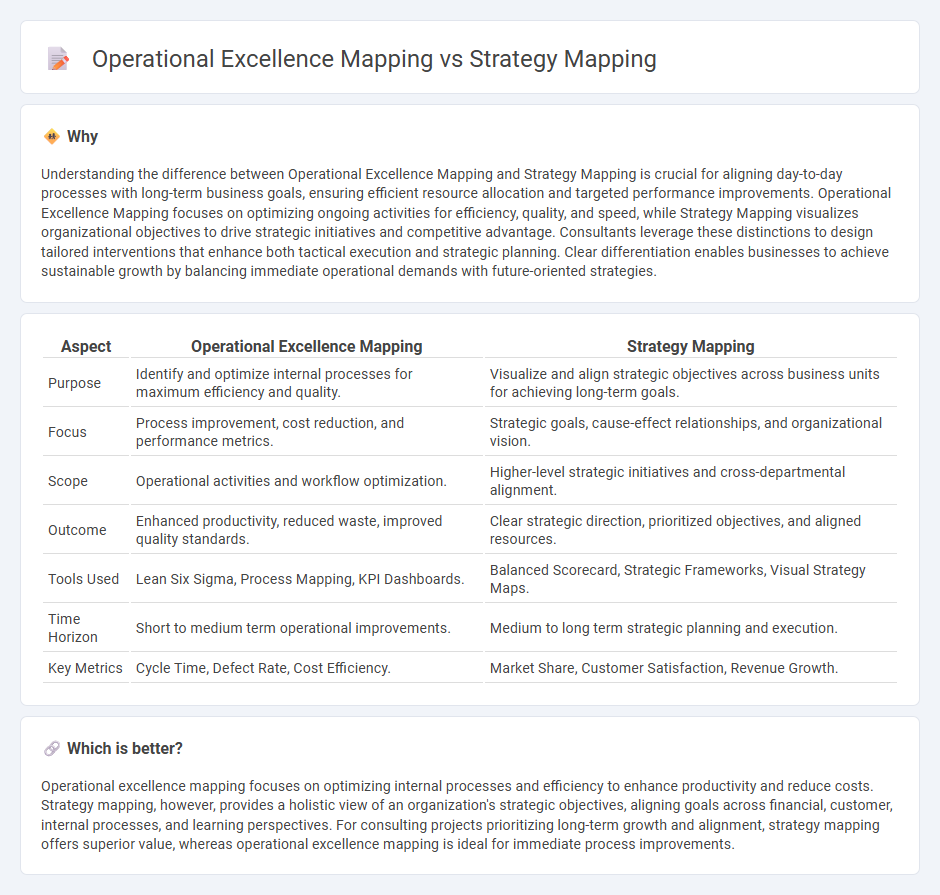
Operational excellence mapping focuses on optimizing processes and improving efficiency within an organization by identifying waste, streamlining workflows, and enhancing performance metrics. Strategy mapping, in contrast, aligns business objectives with key performance indicators and strategic goals to visualize cause-and-effect relationships that drive organizational success. Explore how integrating these methodologies can elevate your company's overall performance.
Why it is important
Understanding the difference between Operational Excellence Mapping and Strategy Mapping is crucial for aligning day-to-day processes with long-term business goals, ensuring efficient resource allocation and targeted performance improvements. Operational Excellence Mapping focuses on optimizing ongoing activities for efficiency, quality, and speed, while Strategy Mapping visualizes organizational objectives to drive strategic initiatives and competitive advantage. Consultants leverage these distinctions to design tailored interventions that enhance both tactical execution and strategic planning. Clear differentiation enables businesses to achieve sustainable growth by balancing immediate operational demands with future-oriented strategies.
Comparison Table
| Aspect | Operational Excellence Mapping | Strategy Mapping |
|---|---|---|
| Purpose | Identify and optimize internal processes for maximum efficiency and quality. | Visualize and align strategic objectives across business units for achieving long-term goals. |
| Focus | Process improvement, cost reduction, and performance metrics. | Strategic goals, cause-effect relationships, and organizational vision. |
| Scope | Operational activities and workflow optimization. | Higher-level strategic initiatives and cross-departmental alignment. |
| Outcome | Enhanced productivity, reduced waste, improved quality standards. | Clear strategic direction, prioritized objectives, and aligned resources. |
| Tools Used | Lean Six Sigma, Process Mapping, KPI Dashboards. | Balanced Scorecard, Strategic Frameworks, Visual Strategy Maps. |
| Time Horizon | Short to medium term operational improvements. | Medium to long term strategic planning and execution. |
| Key Metrics | Cycle Time, Defect Rate, Cost Efficiency. | Market Share, Customer Satisfaction, Revenue Growth. |
Which is better?
Operational excellence mapping focuses on optimizing internal processes and efficiency to enhance productivity and reduce costs. Strategy mapping, however, provides a holistic view of an organization's strategic objectives, aligning goals across financial, customer, internal processes, and learning perspectives. For consulting projects prioritizing long-term growth and alignment, strategy mapping offers superior value, whereas operational excellence mapping is ideal for immediate process improvements.
Connection
Operational excellence mapping identifies critical processes and performance metrics that drive efficiency and quality, forming the foundation for strategic priorities. Strategy mapping translates these operational insights into a visual framework aligning business objectives, enabling organizations to focus resources on value-creating activities. The integration of both ensures coherent execution by linking day-to-day operational improvements directly with long-term strategic goals.
Key Terms
Value Proposition
Strategy mapping centers on visualizing an organization's objectives and the cause-and-effect relationships that drive strategic goals, emphasizing value proposition alignment to customer needs and market demands. Operational excellence mapping concentrates on process efficiency and continuous improvement to deliver value through streamlined operations and cost reduction. Explore how integrating both approaches can enhance your organization's competitive advantage and customer value creation.
Key Performance Indicators (KPIs)
Strategy mapping emphasizes aligning KPIs with long-term organizational goals by visualizing cause-and-effect relationships between strategic objectives, fostering a clear understanding of performance drivers. Operational excellence mapping concentrates on KPIs related to process efficiency, quality, and continuous improvement to enhance day-to-day operations and reduce waste. Explore these frameworks further to optimize your organization's performance management and strategic execution.
Process Alignment
Strategy mapping emphasizes aligning organizational goals with strategic objectives through visual frameworks that link performance drivers and outcomes. Operational excellence mapping centers on streamlining processes to enhance efficiency, reduce waste, and ensure consistent quality delivery. Explore the distinctions to optimize process alignment and drive superior business performance.
Source and External Links
What Is a Strategy Map? Complete Guide to Strategic Planning | Vibe - A strategy map is a graphical representation of a company's goals and objectives across business growth, client acquisition, and financial health, created through steps including defining goals, perspectives, priorities, and linking goals with cause and effect.
About Strategy Mapping - Balanced Scorecard Institute - A strategy map is a simple graphic showing cause-and-effect relationships between strategic objectives and is developed by cross-functional teams to clarify continuous improvement goals across multiple perspectives.
How To Create a Strategy Map in 6 Steps (With Example) | Indeed.com - Strategy mapping involves visualizing a goal-setting plan organized into perspectives like financial, customer, internal process, and growth, with steps including assessing current performance and evaluating impacts on finances and customers.
 dowidth.com
dowidth.com